14 de June de 2021
Sports Nutrition Strength and science
How much protein does an athlete need?
One of the biggest concerns when starting to improve our diet as athletes is calculating our nutritional requirements. These must be in accordance with our objectives, both at the level of body composition and performance and, if possible, guided by a professional who understands the needs of the sport we practice. Today we know that not all athletes need the same dietary guidelines. Moreover, depending on the time of the season, these needs will change, so we can say that we no longer only have to look at the anthropometry and basic data of the athlete to calculate his requirements. We have to understand his physiology and adapt the diet in relation to the sport he practices, to his stage of preparation, to the degree of adherence and to the psychological context depending on the season. And with that data that we must take into account one of the most important factors, which is the calculation of protein intake.
Within the scientific literature we can read recommendations ranging from 0.6 g / kg of body weight by the FAO in 1985 (1), the minimum of 0.83 g / kg of body weight of the EFSA in 2012 (2) up to 4.4 g / kg revised in the study by Jose Antonio et al. in 2014 (3). As seen in the previous literature, there is a great disparity in terms of protein consumption and therefore we must always attend to the real needs of the athlete and his objectives. Not all the athletes that we meet will have the same requirements, so a smart way to decipher which protein range can be more beneficial is, apart from other factors such as adherence, satiety, etc., to look at their sports profile.
For simplicity we will approach it by differentiating two profiles: endurance sports and strength sports.
Protein in endurance sports
One of the premises in the field of endurance sports is the medium-high consumption of carbohydrates to improve performance. In these types of sports, the nutritional strategy is essential and therefore a classic tactic that is carried out on a regular basis is the consumption of pre-workout carbohydrates in order to start training or competition with higher glycogen reserves (4). Obviously this is quite qualifiable since it has also been seen that training strategies with low availability of carbohydrates (ketogenic diet) can work well for some people, as observed in the study by Phinney SD, et al. (5), and they have become very popular. But in these cases the athlete must be aware of the dietary limitations, the correct and necessary adaptation to perform the same in training (weeks or even months) and a strict control at the level of micronutrients, mainly electrolytes. And it is that a very low carbohydrate or ketogenic diet as in the study by Phinney SD, et al. produces a depletion of glycogen deposits that entails releasing much of the associated water and, consequently, urinating more and excreting much of the minerals with the water. That is why electrolyte control and adequate hydration are so important, especially in the transition period to a very low-carbohydrate protocol. This change in the preference for the use of energy substrates requires an adaptation time both for the metabolism and when facing training.
Ideally, it is interesting to keep a check with a doctor or sports professional in case of any doubt or have any type of pathology such as diabetes, cardiovascular disease, alterations in the lipid profile, etc. And what do carbohydrates have to do with protein? Well, given the importance that carbohydrates have always had in these types of sports, protein has always been a little behind. And this is an error due to several factors, although we will expose the two main ones:
- In endurance sports, and more in medium and long distance running, a large amount of muscle mass can drag down athletes and therefore is not interesting in sports development. But proteins are not only used to gain muscle mass – far from it.
We know that around 1-1.5% of the proteins will serve as an energy substrate (6). In endurance athletes, this contribution to obtaining energy is greater due to increased cardiorespiratory metabolism. And in relation to the use of very low carbohydrate or ketogenic diets, the risk of proteolysis increases (7) due to the decrease in liver and muscle glycogen that can lead to a greater use of proteins as an energy substrate (stated in the previous paragraph).
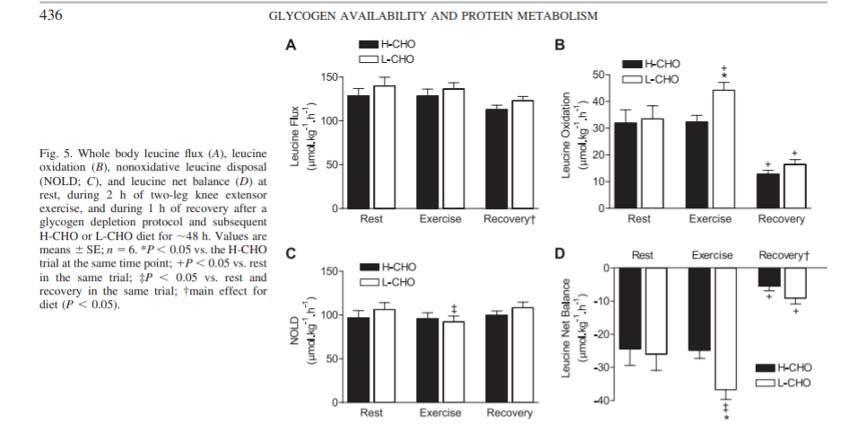
Image extracted from the study by Howarth and collaborators where it is concluded that, in low CHO diets, there is greater protein degradation during exercise and less protein synthesis after exercise. It gives us an idea about the importance of incorporating more protein in the diet and even more when we perform low CHO or ketogenic diet protocols.
2. One of the adaptations that occur through resistance exercise is the increase in mitochondria, the powerhouses of our cells (8). Without going too deep due to the complexity of these biological processes, we must understand that we have a regulatory protein called Protein 1α coactivating the peroxisome proliferator activated receptor (PGC-1α) that acts directly and indirectly in energy homeostasis and oxidative metabolism and, in addition, it acts in the transcription of mitochondrial proteins. And it has been seen that PGC-1α has a greater presence in heart muscle, kidneys, brown adipose tissue and in slow muscle fibers (more oxidative) such as type I and type IIA. This gives us an idea of the importance of supporting these adaptations and signaling cascades to stimulate these processes.
Although our goal in endurance sports is not to gain muscle mass, it should be an objective to optimize and increase mitochondria to improve energy production, which, by definition, will improve our performance. And it has been observed in Bohé’s 2003 study (9) that amino acids in proteins stimulate this mitochondrial biogenesis. If we also use strategies such as supplementing with protein after exercise, we could improve these adaptations (10).
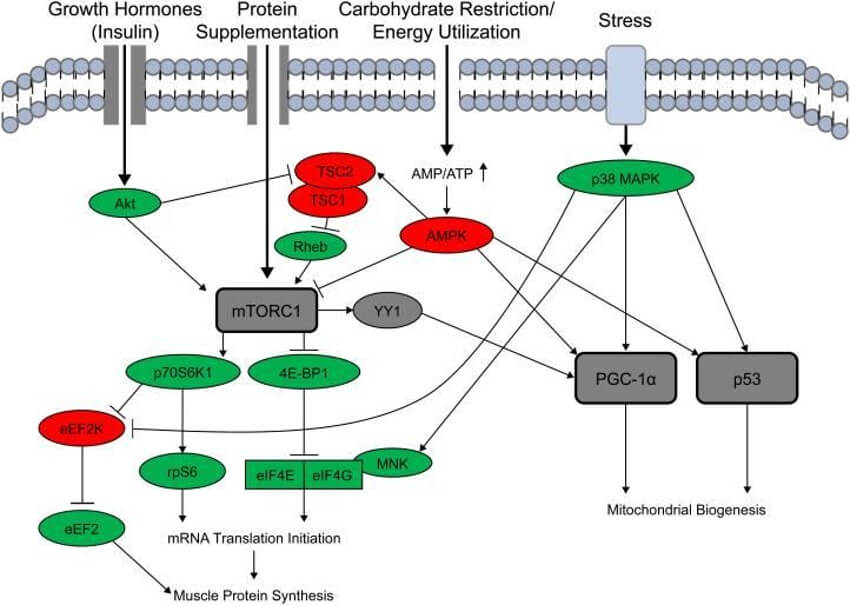
Image taken from the study by Margolis and Pasiakos (2013) Optimizing Intramuscular Adaptations to Aerobic Exercise: Effects of Carbohydrate Restriction and Protein Supplementation on Mitochondrial Biogenesis, where “triggers” of the PGC-1α pathway are observed, including carbohydrate restriction via the AMPK pathway (as in a ketogenic diet, for example) or via the mTORC1-YY1 cascade.
As practical recommendations, we can take note of Lemon’s review (11) where we observed that an appropriate choice could range from 1.2 to 1.4 g / kg of protein body weight.
Protein in strength sports
By definition, when we talk about strength sports, we refer to any sporting activity and modality that involves training, such as VBT training, for the gain of muscle mass and / or improvement in the ability to express force in all its variants. We talk about sports such as bodybuilding, powerlifting, weightlifting, strongman, harri-jasotze (Basque stone lifting), etc. Sprinters of short distances such as 100m could also be included in this selection.
As a general rule, most of these sports compete by weight class. For this reason, the dietary guidelines of these athletes usually vary throughout the year depending on the period in which they are. In addition, in these sports the consumption of protein and the importance given to it is usually greater than that of endurance sports.
Something common is to see the typical recommendation of 2 g / kg of body weight as the standard for any type of person, although, as we will see below, this is quite variable since, as we have just mentioned, the competitive period influences.
An extreme case would be bodybuilding where diet is a primary part of the preparation and the changes and adjustments that are made in this sport go a little further as we will see later.
As we well know, in addition to a positive energy intake, a correct and adapted training and sufficient rest, a positive nitrogen balance is needed to improve performance (12) since it is necessary for the regeneration of tissues and the maintenance or increase of lean mass.
In this sense, we find different studies and recommendations that vary greatly depending on the population studied, age, physical activity, type of diet (hypocaloric, isocaloric or hypercaloric), etc. Among the studies carried out with strength athletes, we can talk about the study by Mäestu et al (13) with amateur bodybuilders where it was verified how a hypocaloric diet high in protein (approximately 2.5 g / kg body weight) for 11 weeks managed to retain most of the fat-free mass of the subjects.
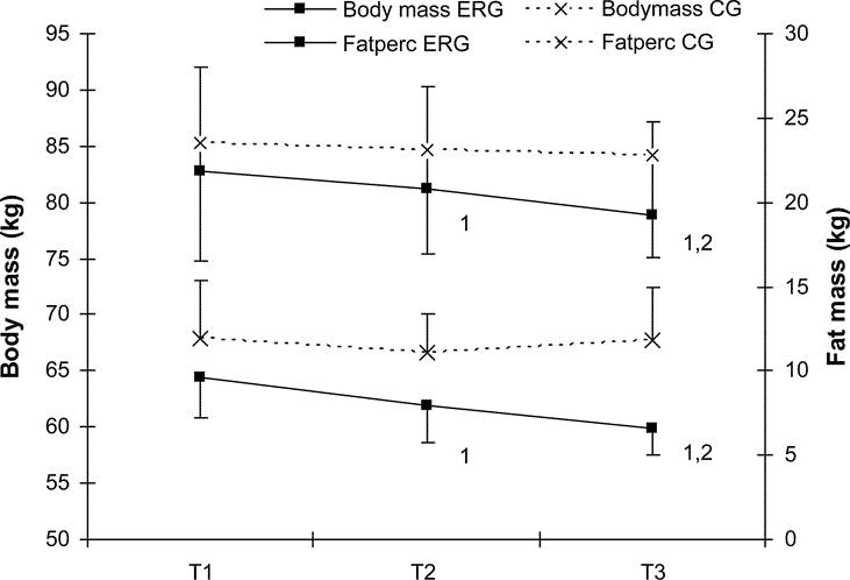
Image extracted from the study by Mäestu et al showing the bodybuilders group (ERG) a change in fat-free mass and fat percentage from: 82.9 ± 9.3 to 78.8 ± 8.4 kg and from 9.6 ± 2.3 to 6.5 ± 1.5%, respectively). In addition, according to the authors, “No significant changes in body mass index, lean body mass, bone mineral component or lumbar bone values were observed in ERG or CG (data not shown).” CG: control group.
An even higher consumption of protein does not entail a greater benefit in terms of improving body composition as seen in the study by José Antonio et al. In 2014 (3) where they compared two groups of weightlifters, one with a consumption of 4, 4 g / kg body weight of protein along with another group that consumed 1.8 g / kg.
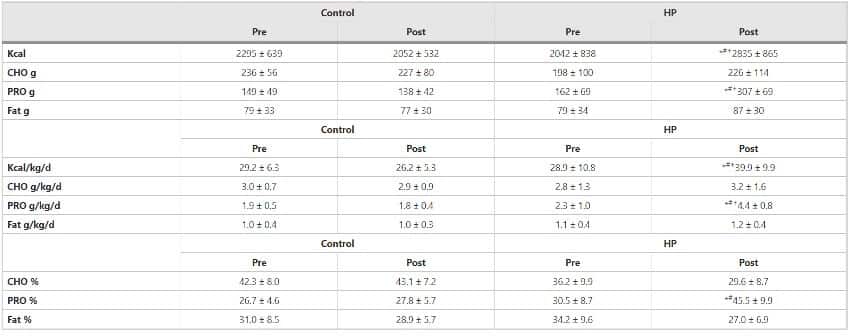
Dietas de los sujetos en el estudio de José Antonio y colaboradores.
No significant changes were observed, so if our intention is to improve performance and body composition, opting for the consumption of 1.8 g / kg is a more coherent option within a general context. It should also be noted that those who consumed the highest protein diet had a considerable surplus and therefore it must be taken into account that, despite this, they lost more fat than the other group. The thermal effect of protein digestion is a variable that could have influenced the latter. And as a final note of the study, the training of the subjects was not modified.

Cambios en la composición corporal entre los sujetos de control y los que llevaron una dieta alta en proteína (HP) en el estudio de José Antonio y colaboradores.
To make a more practical recommendation, ranges of 1.4-2 g / kg body weight of protein seem to be a sufficiently wide and safe range for the vast majority of athletes, seeking the highest range in periods of fat loss to ensure we preserve as much as possible the greatest amount of muscle mass. In addition, it is acceptable to consume these amounts of protein spread over various intakes throughout the day without having to rely on protein shakes like the subjects who consumed 4.4 g / kg of protein.
Conclusions
When implementing these recommendations and practices in sports nutrition, we must take into account both the type of training we do and the objective in terms of body composition. Additionally, protein has been demonized over the years and the vast majority of people have not taken into account various factors such as adaptation to training helps to minimize the use of protein as a substrate energy (14) and makes muscle more efficient with the use of protein for anabolic purposes (15). In the study by Campbell et al. (16) two diets were compared: one with 0.8 g / kg and the other with 1.6 g / kg of protein and it was seen that after 12 weeks of training the 0.8 g / kg group was more efficient with the retention of protein nitrogen, so it can be said that at a theoretical level the lower intake of protein in the diet was compensated with an improvement in protein synthesis and less oxidation of amino acids.
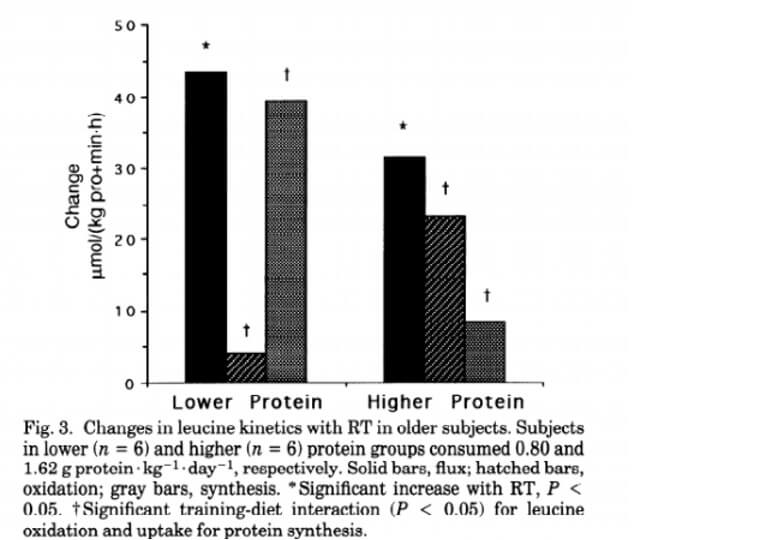
Figure from the study by Campbell et al. 1995 where using the parameter of leucine (amino acid “activator” of protein synthesis) shows the metabolic compensation made by the subjects with the lowest protein diet.
As a final reflection, it must be emphasized that nutrition professionals must pay much more attention to what the studies say. You must always seek a consensus with trainers that combines not only performance and / or aesthetic goals / body composition, but also adjusts to the demands at the organoleptic level, satiety … even habits and dietary habits of a personal or religious nature. Therefore, periods higher or lower in protein will not make a big difference in the objectives if the person feels that the diet is adequate to their tastes and needs. The global calculation of the training, rest and nutrition triad will be what makes the difference in the medium and long term.
References
(1) Energy and protein requirements: report of a Joint FAO/WHO/UNU Expert Consultation [held in Rome from 5 to 17 October 1981].
(2) Scientific Opinion on Dietary Reference Values for protein. EFSA Journal 2012;10(2):2557.
(3) Antonio, J., Peacock, C.A., Ellerbroek, A. et al. (2014). The effects of consuming a high protein diet (4.4 g/kg/d) on body composition in resistance-trained individuals.
(4) E F Coyle, A R Coggan, M K Hemmert, R C Lowe, T J Walters (1985). Substrate usage during prolonged exercise following a preexercise meal.
(5) S D Phinney, B R Bistrian, W J Evans, E Gervino, G L Blackburn (1983). The human metabolic response to chronic ketosis without caloric restriction: preservation of submaximal exercise capability with reduced carbohydrate oxidation.
(6) Tarnopolsky (2004). Protein requirements for endurance athletes.
(7) Howarth, K. R.; Phillips, S. M.; MacDonald, M. J.; Richards, D.; Moreau, N. A.; Gibala, M. J. (2010). Effect of glycogen availability on human skeletal muscle protein turnover during exercise and recovery.
(8) Jonathan P. Little, Adeel Safdar, Naomi Cermak, Mark A. Tarnopolsky, and Martin J. Gibala. American Journal of Physiology-Regulatory, Integrative and Comparative Physiology (2010). Acute endurance exercise increases the nuclear abundance of PGC-1α in trained human skeletal muscle.
(9) Bohé J, Low A, Wolfe RR, Rennie MJ. (2003). Human muscle protein synthesis is modulated by extracellular, not intramuscular amino acid availability: a dose-response study.
(10) Lee M. Margolis and Stefan M. Pasiakos (2013). Optimizing Intramuscular Adaptations to Aerobic Exercise: Effects of Carbohydrate Restriction and Protein Supplementation on Mitochondrial Biogenesis.
(11) Peter W. R. Lemon (1997) Dietary protein requirements in athletes.
(12) Stuart M. Phillips and Luc J.C. Van Loon (2011) Dietary protein for athletes: From requirements to optimum adaptation.
(13) Mäestu, Jarek; Eliakim, Alon; Jürimäe, Jaak; Valter, Ivo; Jürimäe, Toivo (2010) Anabolic and Catabolic Hormones and Energy Balance of the Male Bodybuilders During the Preparation for the Competition.
(14) PJ Reeds, TW Hutchens (1994) Protein requirements: from nitrogen balance to functional impact.
(15) MJ Rennie (2011) Control of muscle protein synthesis as a result of contractile activity and amino acid availability: implications for protein requirements.
(16) Campbell et al. (1995) Effects of resistance training and dietary protein intake on protein metabolism in older adults.

